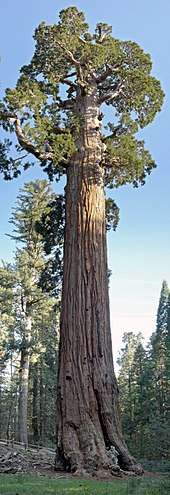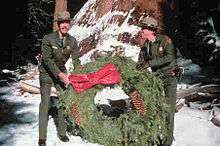General Grant (tree)
The General Grant tree is the largest giant sequoia (Sequoiadendron giganteum) in the General Grant Grove section of Kings Canyon National Park in California and the second largest tree in the world. Once thought to be well over 2,000 years old, recent estimates suggest the General Grant tree is closer to 1,650 years old.[1] The tree also features the third largest footprint of any living giant sequoia, measuring 107.6 ft (32.8 m) in circumference at ground level.[2]

History
The tree was named in 1867 after Ulysses S. Grant, Union Army general and the 18th President of the United States (1869–1877). President Calvin Coolidge proclaimed it the "Nation's Christmas Tree" on April 28, 1926. Due in large part to its huge base, the General Grant tree was thought to be the largest tree in the world prior to 1931, when the first precise measurements indicated that the General Sherman was slightly larger. On March 29, 1956, President Dwight D. Eisenhower declared the tree a "National Shrine", a memorial to those who died in war. It is the only living object to be so declared.[3]
In September 2003, General Grant moved up one place in the giant sequoia size rankings when the Washington tree lost its crown and the hollow upper half of its trunk after a fire caused by a lightning strike.
Dimensions
| Height above base[2] | 267.4 ft | 81.5 m |
|---|---|---|
| Circumference at ground[2] | 107.6 ft | 32.8 m |
| Diameter 4.5 ft (1.4 m) above highest point on ground[2] | 28.9 ft | 8.8 m |
| Diameter 60 ft (18 m) above base[2] | 16.3 ft | 5.0 m |
| Diameter 180 ft (55 m) above base[2] | 12.9 ft | 3.9 m |
| Estimated bole volume[2] | 46,608 cu ft | 1,320 m3 |

References
- Fischer, Douglas (8 December 2003). "Nation's Christmas tree aged 1,650 General Grant in Kings Canyon National Park no young whippersnapper". Oakland Tribune. Archived from the original on 5 November 2012.
- Flint, Wendell D. (1987). To Find the Biggest Tree. Sequoia National Forest Association. p. 94.
- National Park Service. "Sequoia and Kings Canyon National Parks Information Page". Archived from the original on 2007-03-28. Retrieved 2007-03-06.
External links
| Wikimedia Commons has media related to General Grant Tree. |
- Virtual Grant Tree Walk
- "General Grant: Our Nation's Christmas Tree". Archived from the original on 2010-12-24.
- The largest giant sequoias by trunk volume
